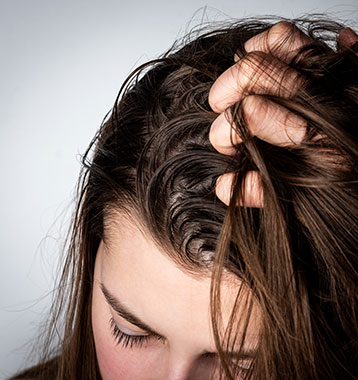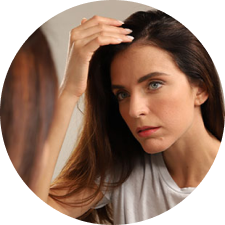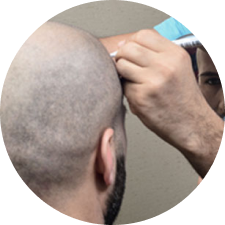- Home
- Greasy hair
hair-problems
Greasy hair
Scientific collaboration between Professor Marco Toscani and Dr. Pasquale Fino, Chair of Plastic, Reconstructive and Aesthetic Surgery, Umberto I Health Center – “Sapienza” University of Rome.

Greasy hair appears dirty, greasy, oily, shiny and often has an unpleasant odor.
Individuals who have greasy hair often also have other areas of the skin (nose, forehead, chin) that are quite greasy (called “seborrheic” skin).
The presence of furuncles, dilated pores and acne could be additional symptoms in patients with greasy hair and scalp problems. These patients may find the presence of greasy dandruff, white or semi-yellow scales made up of dead skin, on the scalp. They may also suffer from itchiness and localized pain on the scalp. These symptoms are caused by the type and excessive quantity of sebum which results in the obstruction of follicles, thereby impeding the healthy growth of hair. Excess sebum production is the cause behind greasy skin and greasy, oily, sticky hair. This sebum is spilled through hair follicles onto the scalp, also surrounding the hair shaft.
Fatty acids, glycerides and wax esters are the main components of sebum. By spilling onto the skin, sebum mixes with cellular waste, skin grease and the sweat produced by the sweat glands. Moreover, the composition of sebum depends on other factors such as drugs, hormones and nutrition. Androgenic hormones are also very important because these are responsible for the quantity and quality of sebaceous secretion in both women and men. Sebum has the function of facilitating skin hydration, lubricating and waterproofing the hair shaft, making it more robust, resistant and pleasant from an aesthetic point of view, and of establishing a film or a hydrolipidic layer that protects the skin from external agents such as the sun, the cold and bacteria.
In the presence of a hyper-secretion of sebum (seborrhea), the functions of sebum are altered and the hydrolipid equilibrium fails, jeopardizing the health of the hair and consequently causing hair and scalp problems. Seborrheic dermatitis, with symptoms such as scalp itchiness and irritation, is a possible outcome of the presence of excessive sebum, which may degenerate into seborrheic hair loss. Seborrhea is an aesthetic or hygienic problem. Excessive production of sebum and defects in its quality may in time damage and ruin hair, leading to hair loss.
Sebum contains toxins and waste produced or introduced in our system. We can identify two types of sebum: greasy sebum and oily sebum. Greasy sebum is dense and is located on the skin, making it greasy. Oily sebum is more liquid and is distributed easily onto hair, making it greasy and oily.
The problem with greasy hair is not only related to excessive greasy sebum production (seborrheic dermatitis), but also to its excessive liquefaction and transformation into oily sebum. Sin this case, since it is more fluid, it becomes localized on the hair shaft.
Genetic predisposition is afactor in the excessive production of sebum. Sebaceous gland activity is controlled by hormones.
Among the causes of greasy hair (endogenous and exogenous causes), we can list: stress, nervous system factors, hormonal imbalances, digestive disturbances, self-intoxication and metabolic disturbances (nutrition). A concurrent cause of greasy hair is hyperhidrosis of the scalp or excessive sweating. Hyperhidrosis results in the dissolution of sebum as the water expelled by the sweat glands mixes with the sebum, making it more greasy and oily. Usually hyperhidrosis is not associated with a greasy face and skin.
The use of the wrong anti-seborrheic shampoos or other grease-fighting products that are too aggressive may be included among the potential causes of greasy hair, as their use could result in excessive production of sebum, which aggravates the problem.
Some precautions and the use of a suitable treatment for hair may help to reduce an excessive production of sebum.
The frequency with which the hair is washed should be increased (no more than once per day in complex cases), as this allows the skin to free itself of excessive sebum, allowing the hair to “breath”.
It is important to use a delicate shampoo with a sebum-balancing action, containing cysteine derivatives, B vitamins or Panthenol, all of which are substances that help to avoid removing too much sebum from the skin, thereby depriving it of its natural protection.
It is important to also use a mask with an astringent effect and antibacterial and antiseptic properties to “dry out” the skin and purify it by eliminating waste and bacteria.
Do not dry hair at high temperatures or by holding the hair dryer too close to the skin because this causes a thinning of sebum, thus increasing its production.
Avoid long scalp massages which may stimulate the sebaceous glands to produce sebum.
One last remedy, although not without contraindications, is the use of finasteride to combat the dihydrotestosterone action responsible not only for excess sebum but also for hair loss.
State-of-the-art hair treatments exist that act deep in the skin, influencing follicle activity. Moreover, laser treatments improve cutaneous vascularization blocked by the pressure that excess sebum has on a follicular level. In conclusion, remember that greasy hair is not just an aesthetic problem, but a symptom of a skin anomaly that may damage hair, increasing hair loss.
Hair and Scalp
READ ALL ARTICLESHair Loss
READ ALL ARTICLESHair Problems
READ ALL ARTICLESScalp Problems
READ ALL ARTICLESAlopecia
READ ALL ARTICLESPreventions and Solutions
READ ALL ARTICLESHair loss solutions for you. CRLAB, specialists in the well-being of your hair and scalp.
FIND YOUR NEAREST CENTER
Let our experts find the best solution for you.
FIND YOUR NEAREST CRLAB CENTERBOOK A CONSULTATION
Book a consultation with our experts. Find out more about CRLAB solutions.
MAKE AN APPOINTMENTTrichology scalp and hair care
To put the health back into your hair, you first need to nourish your scalp. Our trichology treatments care for your scalp and hair, using cutting-edge technologies with a full range of laboratory-tested products. All made with high quality raw materials.
Find out moreHair prosthetic system
The ultimate answer to your hair loss. Rediscover yourself, with naturally thick hair. A patented solution that integrates real hair into areas where you’re experiencing thinning or hair loss. A fully customized hair enhancement that will look totally natural on you. Plus, it’s so functional, it gives you the freedom to live your life the way you want to.
Find out moreHair transplant surgery
Hair transplantation is recommended for those who wish to improve hair density and coverage. The degree of thinning may vary and must be assessed in relation to the donor area.
Find out more
 Italiano
Italiano  Português
Português  Français
Français  Español
Español 




